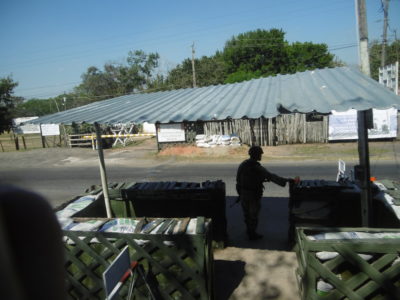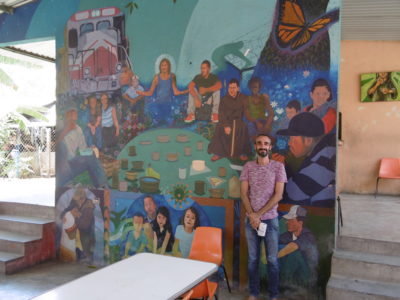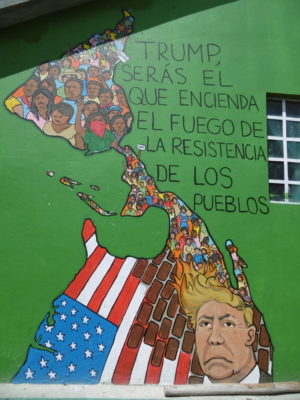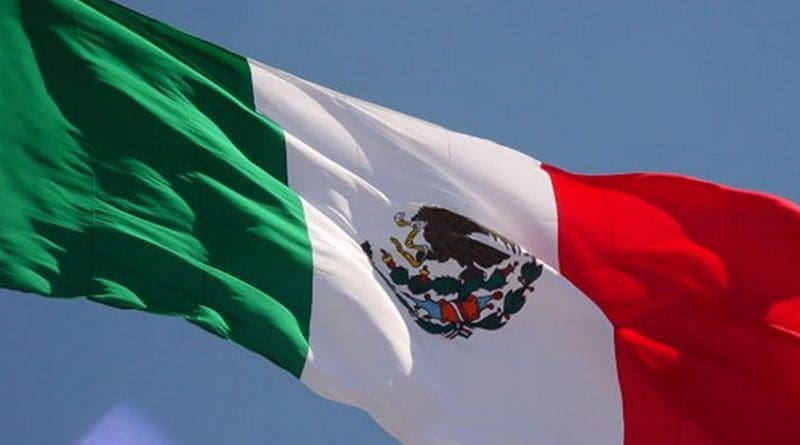The Future Of Mexico: The Other Mexican Border – Analysis
By Published by the Foreign Policy Research Institute
By David Danelo*
(FPRI) — You should have said something,” a perturbed Chilean university professor tells me in Spanish, soon after we disembarked from a bus in Córdoba, Mexico. Wearing combat boots, fatigues, and a shaved head with scrubby facial hair, the short, slender, middle-aged man had watched me get inspected three times by Mexican migration and military personnel while traveling north from the Mexico-Guatemala border. At each checkpoint, I was the only passenger who drew attention; my passport and documents permitting me to travel through Mexico were scrutinized, and each compartment in my backpack was unzipped. The Chilean, who looked like he could have been in the military himself, claimed he was an advisor to Mexican border forces. “They were profiling you. They are not supposed to do that.”
I laughed. Of course, they were profiling me. I look exactly like what I am: a gringo; a güero; an American. Given the attitude the United States government has directed recently towards Mexico, why wouldn’t I be a primary target for extra security screenings? I considered myself fortunate that Mexican authorities were content with seeing my passport and searching my backpack. All things considered, it was a courteous reprieve.

The military and law enforcement presence in Mexico’s south is not a new development. On the country’s border with Guatemala and Belize, the United States has assisted Mexican authorities since 2014 with interior checkpoints and inspection technology through the Obama administration’s Plan Frontera Sur. Although American authorities have wanted Mexico to build up security on its southern border for years in an attempt to decrease Central American migration into the United States, Mexico has its own reasons for maintaining strict controls. Whether the partnership continues remains to be seen; the Trump administration, while bellicose about Mexico’s northern border, has said little about any strategic interest in its southern one.
For several weeks in early 2017, I journeyed throughout Mexico, traveling by airplane, bus, and shared taxi from Tenosique on the country’s southern border with Guatemala, through the states of Veracruz and Puebla, into Mexico City, and to Tijuana and Ciudad Juárez, a pair of border cities infamously stereotyped as dominated by violence. With a population of 122 million, Mexico faces its most complex economic, political, and social challenges in decades. Having successfully tied its economic growth to the North American Free Trade Agreement, and, concurrently, to its two northern neighbors, the prospect of a trade war has rattled Mexico’s currency, inflated commodities, and worsened the impact of a long-planned fuel price increase.
But presuming current U.S. immigration policies remain in place, no issue will impact Mexico more than migration for the remaining decade. By July 2018, when Mexico elects a new president for another six-year term, the country is on track to receive more applications from immigrants into its asylum system, by proportion of population, than either Canada or the United States. The last time that Mexico experienced such an influx of newcomers took place almost two hundred years ago when a wave of white American immigrants destabilized Mexico’s northern frontier, eventually provoking two wars that resulted in the cessation of almost half of the country’s territory. These migrations will fuel both instability and opportunity in Mexico, as Central American refugees and North American returnees enter a country that, while handling multiple obstacles, may soon be in its strongest global position since before World War II.
The New Migrant’s Dream
“Give me your tired, your poor, your huddled masses yearning to breathe free.” From the Chinese Exclusion Act of 1882 to President Donald Trump’s proposed wall, the penultimate line of the Emma Lazarus poem has never fully aligned with either United States immigration law or public sentiment. Despite the inconsistency between ideal aspiration and legal reality, the Statue of Liberty’s inscription illustrates how many perceive the United States as a beacon of hope. This perception of American exceptionalism has, for over a century, sustained migratory flows into the U.S. for mythical prospects of economic prosperity. These aspirations have also provided American diplomats with moral leverage when negotiating with authoritarian or despotic regimes throughout the world in general and the Western Hemisphere in particular.
But the United States has now made it clear—through rallies, votes, and the Trump administration’s immigration policies—that it no longer considers the tired, poor, and huddled masses to be worthy of any welcome at all. With the door into the U.S. under lock and key, many are either seeking asylum in Mexico or refusing to go north. In March 2017, the U.S. Department of Homeland Security released a report trumpeting the “unprecedented decline” in apprehensions on the U.S.-Mexico border, largely because fewer Central Americans are arriving. Likewise, at the “La 72” refugee shelter in Tenosique, 40 miles northwest of the Guatemala border, Director Ramón Márquez told me around 500 people arrived from Central America in February 2017 seeking aid—well below half of the monthly average during the three previous years.[1]

One example is María, 33, a Honduran mother of four who lives in Tenosique now after having traveled as far north as Veracruz in search of asylum.[2] In November 2013, her first husband lost his leg from an accident while traveling on a train, eventually dying from his wounds. María’s oldest son and her mother had remained in Honduras, and she lived as a young widow for two years in a series of refugee shelters in Mexico with her two sons. Eventually, she made her way to Tenosique with another Honduran refugee, a slightly younger man with no children whom she married last year. The couple now has a newborn daughter, and María proudly told me of her youngest child’s Mexican citizenship.
“I only got as far as the sixth grade before I had to go to work,” María said. “My daughter will be able to go to university here.” If granted Mexican citizenship, the mother’s two preteen sons may eventually also qualify for higher education benefits. Even without that incentive, her six-year-old son’s broken arm—the product of the same childhood accidents of six-year-olds worldwide—had been treated in a Mexican health clinic and was healing in a proper sling and plaster cast when we spoke. María’s dream was once the United States, but is now Mexico.
Given that Mexico averaged deporting 9 of 10 Central American migrants in 2016—the highest in the Western Hemisphere—the country has been sending a message that migrants are no more welcome in their country than in the United States.[3] That statistic seems to suggest migrants are unwelcome in Mexico, but that would be a misleading conclusion. Like the United States, Mexico’s immigration system is overwhelmed; founded in 1980 amidst Guatemala’s civil war, the Mexican Commission for Refugee Assistance (COMAR) anticipates at least 20,000 asylum petitions this year. COMAR has seen asylum applications more than double since 2015, from around 3,000 to over 8,000 applicants.
But unlike the U.S., Mexico’s refugee law permits any foreigner the right to request asylum; even Americans can (and have) qualified. Ironically, the high rate of deportations suggests that Mexico is far more efficient in judicial rulings of immigration cases than either Canada or the United States. In both countries, a paucity of immigration judges relative to the case backlog has left waits of up to two years before asylum requests are brought before review. Mexico’s law, in contrast, requires asylum requests to be ruled on within 45 days.
Shared Borders and American Security
Even though Mexico has its own motives for securing its southern border, the United States has an interest as well. From an American security perspective, the 21st century’s international border management system is a fragile ecosystem of cooperation through information exchanges, shared inspections, and public-private partnerships between the United States, other countries, and multinational transportation companies. For over 15 years since the September 11 terrorist attacks, U.S. authorities have rewarded participation in a global system of transit that encouraged free movement for as many “trusted” travelers and traders as possible. U.S. Homeland Security programs like Global Entry, TSA PreCheck, NEX U.S., SENTRI, C-TPAT, FAST—and similar schemes in other countries—may have different names and clever sounding acronyms, but each offers the same practical bargain: provide access to your data and permission to inspect your cargo (or you) in another country, and in exchange, you’ll receive head of the line privileges and lighter inspection at the actual border checkpoint.

There have been many arguments advanced against the Trump administration’s immigration policies as racist and xenophobic. Beyond that, the president’s policies threaten the border security data sharing infrastructure, which decreases U.S. security. Whether through stationing American immigration enforcement officers at London’s Heathrow Airport, scanning containers prior to embarkation onto cargo ships in Shanghai, or funding increased security forces on Mexico’s southern border, the idea of policing borders beyond the United States has become standard practice for border patrol agents and customs officers. Enabling people and things to move as freely as possible around the world is a global concern, and partnerships with other countries increase trade and travel efficiencies.
Setting aside privacy and surveillance concerns, these international agreements depend on shared values and trust that the Trump administration’s policies, and the President’s rhetoric, have severely compromised. For information exchanges to be credible, other countries must believe their data will not be misused to injure their own citizens. Partnerships between border authorities from different countries require shared understanding that security concerns—not national origin, religion, or ethnicity—are the factors evaluated when people seek entry. In addition to indecency, inhumanity, and illegality, the current presidential executive orders have increased, rather than reduced, insecurity at border transits by eviscerating this common ethos.
An Inevitable Clash of Civilizations?
In 2005, political scientist Samuel Huntington argued in his final book, Who Are We? The Challenges to America’s National Identity, that immigration in general, and from Latin America in particular, was incompatible with Western civilization. “All societies face recurring threats to their existence, to which they eventually succumb,” Huntington wrote. His thesis was a corollary to his most influential work, The Clash of Civilizations, which hypothesized that cultural and religious identity would be the primary cause of 21st century political conflict. States weak in cultural identity, he said, were most likely to fall to those with stronger cohesion.
Because Huntington believed the United States and Canada represent a culture that is impossibly opposed to Latin America, he also believed that what he loosely defined as “Latin American Civilization” could pose the greatest physical danger to the United States—even greater than Islam, he suggested. “Assimilation is particularly problematic for Mexicans,” Huntington claimed. His prescription was straightforward: “Americans should recommit themselves to the Anglo-Protestant culture, traditions, and values that for three and a half centuries have been embraced by Americans of all races, ethnicities, and religions.” Or put another way, Huntington wanted to Make America Great Again well before it was a campaign slogan.
While Huntington’s thesis has been used by white supremacists to justify their hate speech, there is little evidence to suggest his academic argument was rooted in polemics. At the same time, there is scant evidence that Huntington is in any way correct. Much of his “threat” argument focuses on a definition of Latin American Civilization that bears little resemblance to reality. Multiple chapters of Huntington’s book are dedicated to the fear of the Southwestern United States and Northern Mexico forming its own nation, a risk that is, in turn, almost entirely cited by quotes from one University of New Mexico activist professor.[4] Although political scientists point to secession activists in California (and Texas) as a sound argument for this breakaway risk, I struggle to grasp the logic in establishing American national security strategy and immigration policy by this perceived risk. By that standard, the United States should build a wall immediately between Quebec and Vermont, lest the Green Mountain Boys start getting too excited about establishing their own Second Republic.
To Intimidate or Inspire
“America has two fundamental powers,” Defense Secretary James Mattis said on January 12, 2017 at his Senate confirmation hearing. “One is the power of intimidation. I was part of it and America will defend herself and our idea, this experiment that we call America. And that’s all it is, is an experiment in democracy. But the other power I think that perhaps we have used less in recent years, last 20 years maybe, is the power of inspiration. And I think that the power of inspiration of America at times has got to be employed just as strongly.”
For over 200 years, the power of inspiration—of building a life; raising children; working for profit; achieving equality—framed the American idea of itself and in relationship to the rest of the world. The mythic American Dream was e pluribus unum, that life, liberty, and the pursuit of happiness were possibilities for all, regardless of race, religion, or creed. Although many Americans were aware that it was only a myth, the one unifying belief that all Americans could pretend to claim—regardless of their birthplace—was that no culture usurped another in the United States; that out of many, we could indeed become one.
Losing the power of inspiration is, indeed, a threat to American security: not just at the border, or because of shared intelligence, but because the moral legitimacy of the United States, even if only perceived, is what has provided the country with its greatest leverage in its darkest hours. “The moral is to the physical as three is to one,” Napoleon said about warfighting. His dictum applies even more so in policymaking.
“The people of the United States like to believe that political will and good intentions can solve most human dilemmas,” wrote American historian T.R. Fehrenbach in his 1972 book Fire and Blood: A History of Mexico. “They often find it hard to understand Mexicans, who know better.” As Mexico confronts the most profound economic struggles it has faced in a decade and the country’s immigration system handles unprecedented challenges on both the northern and southern borders, advocates for good governance in the United States should certainly hope our southern neighbor can rise to the occasion. Whether Mexico City is able to handle either the cost or the challenge for these new dreamers, however, is another matter entirely.
The second part in this three part series will focus on Mexico City and its political evolutions.
About the author:
*David J. Danelo’s latest book, The Field Researcher’s Handbook: A Guide to the Art and Science of Professional Fieldwork (Georgetown University Press, 2017), will be released in April 2017.
Source:
This article was published by FPRI.
Notes:
[1] The shelter’s name, La 72, refers to the August 2010 massacre of 72 migrants by the Los Zetas drug cartel in San Fernando, Tamaulipas.
[2] Pseudonyms for refugees and informants of other sensitive information will be used throughout this article series for identity protection.
[3] Patricia Vélez Santiago and Alejandro Fernández Sanabria, “México levanta un muro invisible.” Univisión.com. July 15, 2016, accessed April 3, 2017.
[4] See Chapter 9, “Mexican Immigration and Hispanization,” in Who are We?


Extremely sanitized version of truth of Us open door.
First open to slaves considered property and indigent and imprisoned and “spirited” away children form England.
Later open to Chinese as the potential “new enslaved of the plantation system of which the US currency system was based.
Later opened to “other” Europeans to settle the lands grabbed from Native Americans.
Those who settled in the “urban” Northeast were often brutalized and worked as if slaves – Irish, German, Italians to name but three countries were immigrants came to escape starvation and or killings.
And the latest – send us your smartest. Perhaps so we can leave our own masses uneducated and therefore malleable.